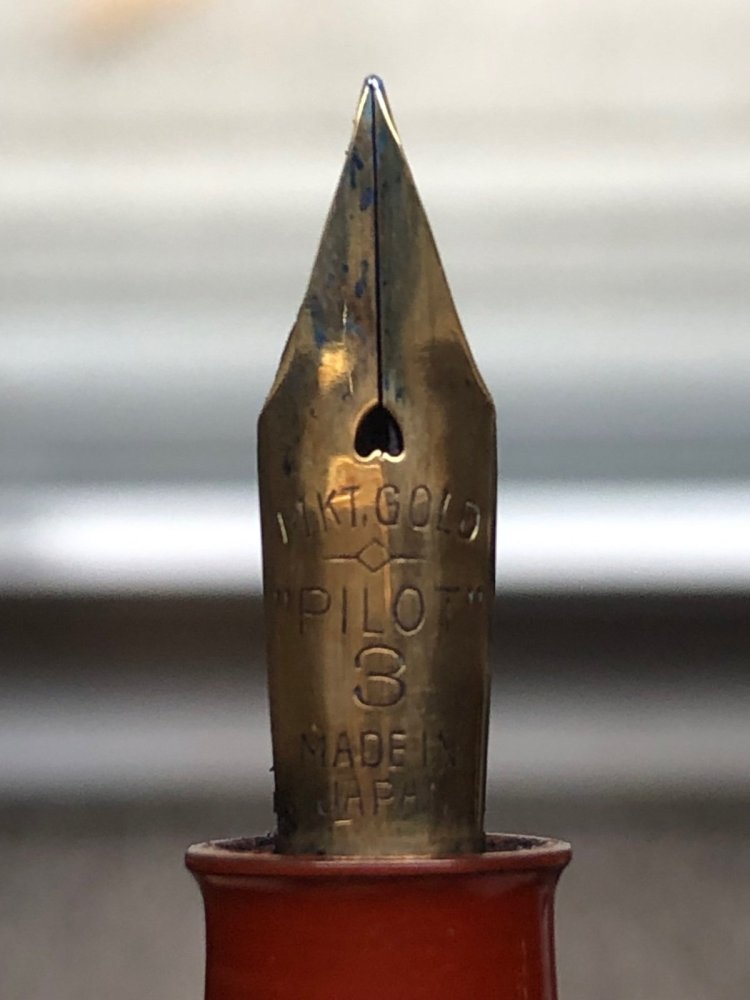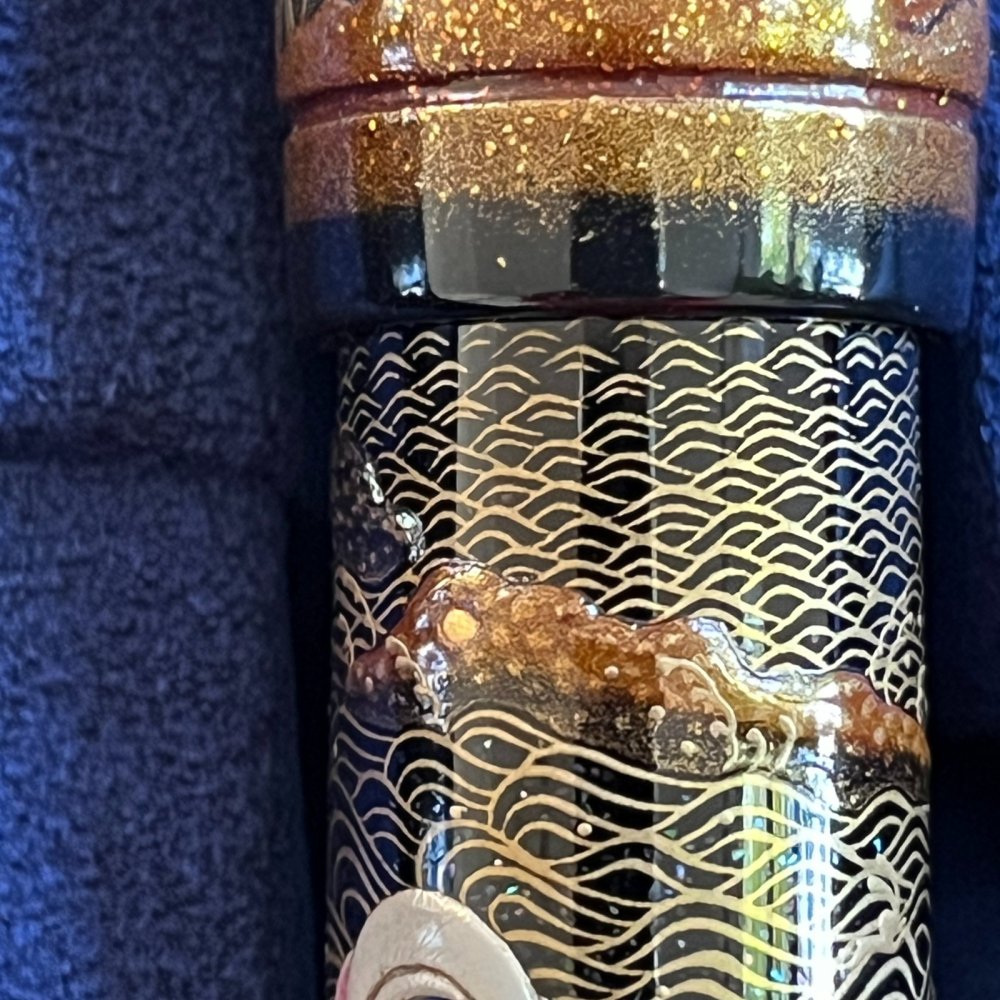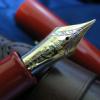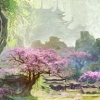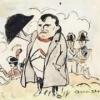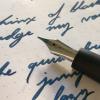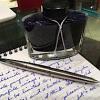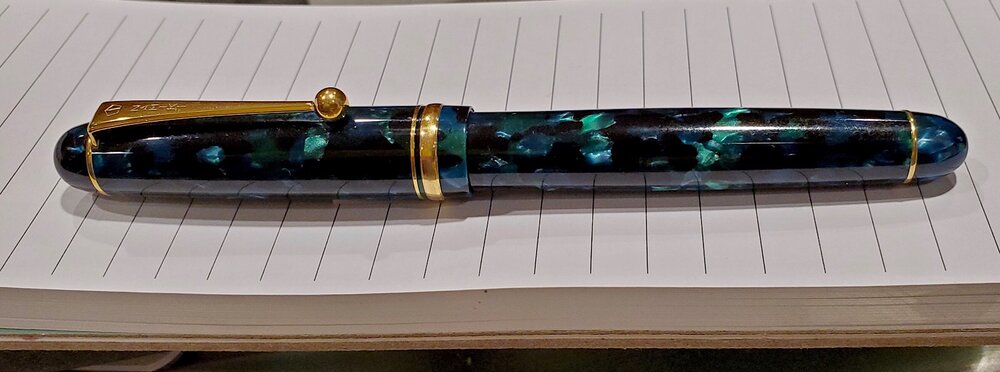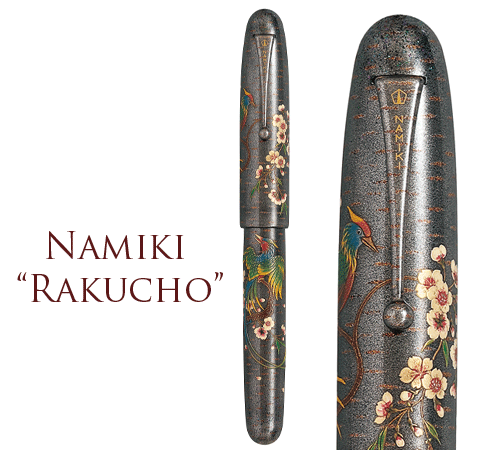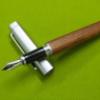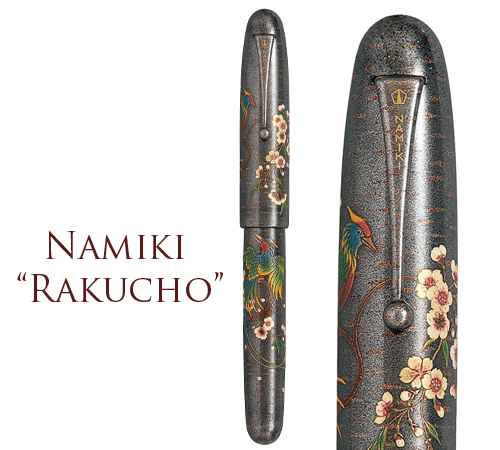Search the Community
Showing results for tags 'namiki'.
-
I have Sailor 1911 L Sailor Compass aka Profit Junior Platinum 3776 Century Platinum President Pilot 74 Pilot 78g Muji pen
-
Anyone know what this is? There is no branding aside from the nib and the clip is broken off… can’t seem to find any records of a Namiki that looks like this or similar.
-
To celebrate the 105th anniversary of the Namiki group, Pilot Namiki is launching this White Rabbit Emperor limited edition '23, made in Shishiai-Togidashi maki-e, the most complex technique of this ancestral art. Since Antiquity, rabbits have been interpreted as auspicious creatures, and the artisan Masahiro Yamada decided to stage the legend of the white rabbit of Inaba and the deity Okuninushi on a background of lacquer and platinum powder. Beautiful work of art!! https://www.sakurafountainpengallery.com/en/boutique/detail/emperor-white-rabbit-namiki-limited-edition-2023-namiki
-
Namiki Yukari Royale versus Pilot Custom 845 http://farm8.staticflickr.com/7346/11918876405_a4b358c5a4_b.jpg Introducing the Namiki Yukari Royale in Black Urushi (top) and the Pilot Custom 845 (bottom). Both pens are resting on a Nakaya three-pen pillow in Kuro Tamenuri Urushi on top of a Midori pad. On the right is a box of Namiki Black ink. Introduction This is a long over-due comparison between two of Pilot's arguably most luxurious mainstream pens, the Namiki Yukari Royale and the Pilot Custom 845. As you all know, the Pilot Corporation uses the Namiki brand for its premium line of writing instruments, much like Toyota uses the Lexus brand and Honda uses the Acura brand for their luxury marquees. The Yukari Royale occupies the second highest rung of Namiki writing instruments, and many people have also made a case for the Pilot Custom 845 being the "flagship" of the regular line-up of fountain pens that Pilot produces, due to its comparatively high MSRP and the superior materials used in its construction. I first acquired the Yukari Royale in 2010, and found it an ideal pen to use. Over time I found myself attracted to the Pilot Custom 845 because it was similar, yet different enough so that I could justify ownership of the pen to myself. So late last year I found an 845 making its way from the sales board into my stable of pens. Some history behind these two pens, according to Fountain Pens of Japan by Andreas Lambrou and Masamichi Sunami (2012), and I paraphrase the information from this invaluable resource here. The Yukari Royale design came from a Balance model first used for the principal pen series made to commemorate Pilot's 80th anniversary in 1998. It was smaller than the #50 FFK Jumbo pen (also known as Namiki Emperor) but bigger than the standard FK Balance model (also known as Namiki Yukari). This limited edition of 1918 pens is long sold-out, but they came in black or red urushi finishes (even the clip was lacquered), and a "four animal gods" lacquer band theme around the opening of the pen cap. See this link from Namiki's website for a picture of this pen and RLD's excellent review of the Pilot 80th anniversary pen. The 845 first debuted in 2002 and its design was derived from the Pilot 75 pen (edition of 7500 pens) made to celebrate Pilot's 75th anniversary in 1993. The Pilot 75 was designed to resemble pens made in the 1930s and it sported a Kikuza clip reminiscent of 1940s-style clips. See Rokurinpapa's extensive review of the Pilot 75 pen. So how do these two pens compare, given their distinguished lineages? First up, their prices. The Yukari Royale has an MSRP of $1500 while the Pilot Custom 845 sells for around $525. Market rates of these pens brand-new hover around $1200 for the Yukari Royale and mid-to-high $400's for the 845. Fortunately, I managed to acquire both pens for much less. Are they worth their suggested retail prices? This will be up to the individual, but for me hunting for a good price is part of the fun in the pen chase. Packaging and Pen Presentation http://farm4.staticflickr.com/3716/11921486675_9a296dfab1_b.jpg The Namiki Yukari Royale pictured in its paulownia wood box. http://farm6.staticflickr.com/5473/11916545376_e7e6dbba02_b.jpg Another picture of the Namiki Yukari Royale in its box. The Yukari Royale comes in a box made of paulownia wood. Included is a bottle of Pilot Blue ink as well as some literature describing the operation of the pen. Notable is a certificate attesting to the authenticity and quality of the urushi finish (not shown). According to the Namiki website, the Yukari Royale comes with a lifetime guarantee: it is "unconditionally guaranteed against failures due to faulty materials or workmanship throughout [its] life with the original owner." http://farm4.staticflickr.com/3818/11916544816_10ee357512_b.jpg The Pilot Custom 845 in its box. The 845 comes in a faux suede-covered box with a velvety-lining inside. One ink cartridge and some literature describing operation of the pen are included. A short card emphasizing the history and excellence of the urushi finish is pictured above. http://farm6.staticflickr.com/5532/11919204383_8d23bbf501_b.jpg The two pens uncapped. Pen Construction and Urushi Finish On to the real comparison. The Yukari Royale is torpedo-shaped and has a underlying body of brass. Conforming to the Japanese aesthetic ideal, it is unadorned, save for a clip as well as a thin gold ring to protect the cap lip from impact. The 845, on the other hand, is styled in the tradition of the Montblanc Meisterstück series but with squared-off ends. There are five trim rings on this pen (including the one on the section) and the cap jewel has a golden ring around it as well. The 845 is made of hard rubber (ebonite), the material traditionally used to make fountain pens. The cap and barrel ends, as well as the section, are made of plastic, however. In his review, MYU had noted that the 845 is a cross between a Montblanc 149 and a Sailor Professional Gear (which itself debuted in 2003), and I concur. I first happened across the 845 in a Hong Kong shop called Winner Pens Collection (you can read my Hong Kong trip report here), and I was taken with its large, yet comfortable size. Both pens have triangular-shaped clips which terminate in a ball, making them highly usable. The Yukari Royale's clip is attached to the cap in a seamless fashion, while the 845's clip is clearly part of the gold trim at the cap end. The Yukari Royale's clip measures 41 mm in length/8 mm at the top while the 845's clip measures 38 mm in length/6 mm at the top. There are four numbers at the top of the Yukari Royale's clip, which might serve as the pen's serial number. More measurements for the statistically-minded here: the Yukari Royale is 46 g capped/29 g uncapped while the 845 is 29 g capped/18 g uncapped. Weights were measured with the converter completely filled. Dimensions: the Yukari Royale is 150 mm capped/134 mm uncapped/179 mm posted, with a diameter of approximately 14 mm, while the 845 is 146 mm capped/132 mm uncapped/165 mm posted, with a diameter of approximately 12.6 mm. Both pens are very well-balanced in the hand, no problems with comfort here. Both pens initially appealed to me because of their urushi finish. I was impressed as well with the history and legendary in-house expertise of Pilot/Namiki in urushi lacquering. The entirety of the Yukari Royale - including the section - is flawlessly lacquered in jet-black urushi lacquer. After four years of hard use, the finish remains impeccably shiny, a testimony to the durability of the lacquer finish. When I first received my 845 last year, I noticed two tiny specks in the lacquer finish towards the barrel end, which are only visible from certain angles and lighting. These specks are probably dust or imperfections in the underlying ebonite body. In any case, these defects did not bother me very much after I inked up the pen and discovered how good of a writer it was. Note that only the ebonite parts of the 845 are lacquered with urushi; the plastic cap and barrel ends, as well as the section, are not. The transition between the urushi and plastic bits of the 845 is seamless - with only the tiny and subtle "URUSHI" gold letters above the cap trim ring serving to remind one of the special lacquer finish. Peering inside the caps of both pens reveals a thin ring of felt that serves to protect the barrel end from marring, should one choose to post the cap on these urushi pens. The felt ring inside the Yukari Royale cap tends to wear away with time, but I haven't found this to affect the urushi finish during normal use. The Yukari Royale comes in both Black and Vermilion urushi finishes, as well as a variety of exquisite maki-e designs. The 845 normally comes in a Black urushi finish, but certain shops in Japan have managed to procure a special Vermilion edition (see here and here and also kmpn's blog for some absolutely breathtaking comparison photos of the Black and Vermilion edition 845 pens, amongst other pens). http://farm4.staticflickr.com/3677/11921489765_1be37c4ca4_b.jpg Comparison of the two sections with attached CON-70 converters. The Yukari Royale is inked with Pilot Blue-Black while the 845 is inked with Pilot Black. Both pens use the superior CON-70 piston converter, arguably the best converter on the market today. I shall not belabour the obvious, except to say that I have had no problems using this filling system. The urushi section of the Yukari Royale tends to stain with Pilot Blue-Black ink but can be cleaned off with some elbow grease. I have had no issues with ink staining the 845 plastic section. http://farm4.staticflickr.com/3774/11916555726_8945294163_b.jpg Close-up of the two nibs: the 845's #15 nib is two-tone while the Yukari Royale in plain urushi finishes come with monotone #20 nibs. The #20 nibs on maki-e Yukari Royale pens are two-tone (the stylized Mount Fuji on the nib is rhodium-plated), however. Writing Experience My Yukari Royale in Black Urushi has a medium #20 nib while the 845 is equipped with a broad #15 nib. The #20 and #15 are approximately the same in length, but have different shapes and feeds. Initially the Yukari Royale nib was a hard-starter. I persisted in using it for approximately six months without much improvement. While cleaning the pen one day, the centre channel rod in the feed came out (also see Richard Binder's page on feeds for more information). Naturally the pen went back to Pilot USA for warranty repair. After it returned, the pen wrote like a dream. I'm not sure what the service centre did but over the course of the last four years, this pen has become my absolute favourite to use. The nib on this pen is springy and extremely responsive, and will lay ink down at the slightest touch to paper. The date code on the nib reads "A809", indicating that it was made by the "A" machine in the Pilot Hiratsuka factory in August of 2009. See kmpn's blogpost for more information on dating Pilot nibs. My 845 pen's broad #15 nib came to me pre-adjusted by Yukio Nagahara of Sailor Pen Company during a pen clinic in India. It writes very well too, requiring absolutely no pressure to put ink onto paper. The date code on this nib is 1210, indicating that it was made in December of 2010 (Since 2010, Pilot has stopped using the "A" and "B" designations on their nibs). In comparison to the Yukari Royale nib, however, the 845 nib is rigid. I have another Yukari Royale with a broad #20 nib ( date code 712 - made in July of 2012), and the nib is inflexible as well. To me, it appears that Pilot broad nibs tend to be more rigid than their finer brethren, perhaps to cater for heavy-handed people? http://farm3.staticflickr.com/2831/11915941023_b990a2faeb_b.jpg Another close-up of the two nibs. http://farm4.staticflickr.com/3732/11916114524_8da4105d9e_b.jpg Side-profiles of the two nibs. The 845's nib tends to stick out more beyond the feed, giving the impression that the user is wielding a brush rather than a pen. http://farm3.staticflickr.com/2810/11915944563_405e387c83_b.jpg See how different the two feeds are! The Yukari Royale's feed is more finned than the 845's feed. Both feeds are made of injection-moulded plastic, however. From this picture, it is apparent that the two nibs are shaped differently as well. The shoulders of the 845 nib tend to flare out a bit more. Conclusions These two pens have excellent construction, an impeccable urushi lacquer finish, write well, and fly under the radar for most people. Either pen is definitely worthy of "grail" status. As might already be apparent from the following pictures, I have chosen the Yukari Royale as my favourite pen to own. Anyway, I hope that you have enjoyed reading this review! Size Comparison to other well-known pens Because more eye-candy is always welcome IMHO. Why would I take photos of all these pens and not share them? http://farm8.staticflickr.com/7369/11916119674_78a7fc57a0_b.jpg Both pens depicted with the Namiki Yukari Royale in Vermilion Urushi. http://farm6.staticflickr.com/5520/11915945783_b74755a931_b.jpgBoth pens depicted with the Namiki Emperor in Vermilion Urushi. http://farm4.staticflickr.com/3682/11915661975_5cf6eec826_b.jpg Both pens depicted with the Sailor King of Pen in Crimson Urushi, reviewed here. http://farm3.staticflickr.com/2873/11915945153_d82eccab9b_b.jpg Both pens depicted with the Sailor Professional Gear Kanreki. http://farm8.staticflickr.com/7319/11916118974_82b36dc5a6_b.jpg Both pens depicted with the Montblanc 149. http://farm8.staticflickr.com/7343/11915937543_41a3e08573_b.jpgBoth pens depicted with the Pelikan M800 in Green. http://farm4.staticflickr.com/3834/11916118674_f73a8ea1ca_b.jpgBoth pens depicted with the Pelikan M800 in Tortoiseshell Brown. http://farm6.staticflickr.com/5547/11923905185_93af11c485_b.jpg Both pens depicted with the Parker Duofold Centennial in Black. http://farm6.staticflickr.com/5477/11916119294_a1a38c6d05_b.jpgBoth pens depicted with the Nakaya Portable Writer in Shobu. A non-exhaustive listing of FPN reviews for the individual pens (Apologies in advance for any omissions) Namiki Yukari Royale: pmrogers, Archimark, enlasombra, enlasombra (again), rhk (comparison between four pens), Mkim, Painterspal, Brian. Pilot Custom 845: J-san, MYU, Hari317, Hari317 (again), seikoguy, Pen2009.
- 45 replies
-
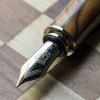
A Review Of Namiki Yukari Royale In Vermillion(Red) Urushi
sannidh posted a topic in Fountain Pen Reviews
A wait longer than words can define, an Emperor in Red singing a glistening rhapsody, and then a Yukari dazzling in Royale Red glory. The pens, an encompassment of elegance of words, combined with precision of maki-e artisans have been unsurpassed. The Yukari did anxiously waited in my hands to have it's first sip of ink and I had same thoughts with what if clauses! Before getting the Yukari, this is a must read-review by FPNer shuuemura, which is a rather poetic series of pictures with practical words, comparing two pilot beauties in black urushi. This pen, one can find ideal for everyday carry to write or to keep admiring the marvel it is! The doubly magnified and magnificent emperor would be more suitable for the latter though. Having said that, when both are together, it’s more fulfilling than a sumptuous meal. PS. Google says Yukari in Japanese means Affinity (上記) and is feminine by gender. In case you are looking for a review of the Yukari Royale or the Emperor (sized pen), the below links redirect to the necessarily ‘unnecessary’ eye-candies on a blogger optimized view The Yukari Royale Review The Namiki Emperor Review A BRIEF HISTORY The Namiki Yukari Royale more or less derives itself from the 80th Anniversary fountain pen (with only 1918 produced) aka the ShiSen, which was launched in 1998. The cap band was then imprinted with four mythical creatures - Dragon, Phoenix, Tiger and XuanWu (Tortoise). The band decorated with the Shijin (four gods) was finished in Togidashi maki-e. The Chinese fable of these creatures goes like this - Each mythical creature is supposed to guard one particular Earth direction and is Harbinger of a particular season. They are respectively, Shujaku - the red phoenix of the South (Summer), Byakko - the white tiger of the West (Autumn), Genbu - the black tortoise of the North (Winter) and Seiryu - the blue dragon of the East (Spring). The latter four are the Buddhist guardians of the four directions who serve Lord Taishakuten (who represents the center), and are associated with China’s Theory of Five Elements. The 80th Anniversary pen is rather excellently reviewed here by RLD. And later, in 2005, another 50 Seki Shun LE pieces (branded as Dunhill Namiki) were made by Pilot/Namiki for the Elephant & Coral Store which are still available. The clip matches the colour of the main finish in the earlier editions, something which may or may not appeal to all of us. URUSHI Urushi as you may know is the otherwise poisonous sap of the urushi or lacquer tree (Toxicodendron Vernicifluum) which grows in Japan, China, and Korea and is primarily brown in colour. The sap of this tree polymerises to form a hard, durable, plastic-like substance, when exposed to moisture/air. Liquid urushi can be applied to multiple materials like wood, metal, cloth, resin, ceramics or ebonite as opposed to the best available synthetic lacquers. When it solidifies, it turns into a very hard coating that is waterproof and protects the coated object from effects of fungus, ambient chemical reactions at surface due to heat or humidity or even from caustic acids. By mixing pigments into cured urushi, colored urushi such as black or shu (red) are made. With natural exposure to air and ultraviolet light (extended UV exposure ends up in discolouration), the urushi layers gradually increase in transparency and the material gradually unveils shades of original bright colours within. Like the Emperor, the Yukari Royale also comes in a spacious wooden box, made of traditional Paulownia wood. The box is protectively packaged inside a cardboard box. I had to let go of the box, while someone hand-delivered the pen, along with the accessories! The model number of the pen, in this case FNK-128S-<R/B>-<F/FM/M/B> contains the launch price, colour and nib width. The 128 refers to the list price of JPY 128,000 whereas the third digit R/B refers to the red/black urushi. THE TORPEDO This Lacquer No.#20 model comes in two standard finishes - Black & Vermillion (Urushi) with gold plated clips. The brass body feels comfortable in hand, from dual perspectives of dimensions and weight. The torpedo shaped pen in Vermillion/Red is adorable in both light and shadow, and when light reflects through layers of urushi, it renders itself an electric red appearance. I believe the brass substrate is partly responsible for its bright hues compared to a relatively darker scarlet hue off the Emperor’s ebonite. The expected fit & finish seem impeccable. The simplistic yet elegant design comes with two golden accents, provided deftly by the traditional triangular shaped tension fit clip with a sphere and a thin gold ring at the cap lip. Again there is a marked absence of any other decoration like a cap band or ring or anything else on the entire pen, extending infinity to modes of artistic convergence. Vermillion is considered as an auspicious colour throughout East Asia, where it’s culturally imbibed. It has four synthetic & natural shades as of today: Red-Orange[sRGB (255, 83, 73)], Orange-Red[sRGB (255, 69, 0)], Plochere[sRGB (217, 96, 59)] and Chinese Red[sRGB (170, 56, 30)]. The shades/hue of the pens in red urushi might vary. The cap finds itself after two turns, revealing a nib with the modern Mt.Fuji inscription. The seamless grip shows a pronounced taper starting from the barrel and ends up with a smoothly carved out bump, rendering continuity. The cap threads on the barrel are carved out with artistic finesse, deftly spaced and carved out of brass. The barrel at the other end leads leisurely to the smoothest tail. The brass cap again displays the most subtle art, sans any discernible extravagance. It carries the same perseverance and focus with a fluid like finish. The finish is impeccable with a parabolic finial and with colours hovering between bright and dark red, with the play of light. The clip is traditional triangular Pilot with a sphere at the end, inscribed with Namiki with the ‘Isosceles Triangle within a Pentagon’ logo. There is a thin gold ring at the cap lip, the only adornment than the golden clip. There is a alphanumeric code inscribed on the upper base of the clip, where it delves into the cap. FILLING SYSTEM - ‘CON-70 ZINDABAD’ The section unscrews from the barrel with three and half turns, with a metallic clink, given the metallic threads on both the section and the barrel. This exposes the golden metallic threads of the section, which would otherwise remain ever hidden! A special CON-70 converter, in black, is pushed inside. The inner barrel carries the opposite metallic threads. With a short black coating near the threads which contacts with the section, the rest of the brass barrel is all exposed metal on the inside. The pen can take all pilot converters CON-20/40/50 (0.4-0.5 mL) & CON-70 (1 mL) along with pilot proprietary cartridges (0.9 mL). I have used the included ‘special black’ CON-70 converter, which has a push button filling mechanism. Mind you, the ink bottle with have some froth during the otherwise fun filling exercise. Although, for Yukari I have always directly filled the converter from an eye dropper! NIB WITH THE ‘OVAL’ BREATHER HOLE The nib with the Yukari Royale is 18k, Size#20 (similar to Pilot#15) and it comes in four stock widths - F, FM, M & B, across Japan and other distribution countries. Inscribed upon it, is the symbol of Mt. Fuji and the upper part does seems symbolic of the snow caps! Comparatively the nib weighs a tad more than a usual pilot#15 nib (0.78g vs 0.70g), but at the same time it is much less wide at the shoulders. The oval breather hole rests within the snow caps. Below the snow, etched are the Namiki Logo (Isosceles triangle inside a Pentagon), Namiki, gold alloy specs (18k-75%) and Nib width <M> On the left the #20 nib carries the Namiki Logo with Ste PP-F hallmark and on the right it carries a simple date stamp. The red plastic feeder does converge with the overall color of the pen, though I would have preferred a similarly urushi coated feeder, which only the Emperor has! May be it’s a feed size limitation, may be Pilot doesn't want to spend more money, I have no idea. The moderately spaced fins ensure levelling ambient air pressure and give you a good buffer, my experience says it’s a tad better than the usual pilot feed. You can see the three different feeds, Size#50 Emperor, Size#20 Yukari Royale & the Size#15 Custom 823, side by side. PHYSICS AS RELATIVELY IT IS The lacquer somewhat helps in keeping the pen warm which is otherwise metallic, and renders it comfortable for writing. The pen is deftly balanced for writing, even for extended use. The grip, smooth & soothing, showcases both utility and elegance at the same time. I do not post the pen as the cap is not as inlaid with as much felt/velvet as the Emperor. Figures for weight and dimensions run below for the technically minded ones. Length closed ~ 14.9 cm Length open ~ 13.4 cm Grip Diameter ~ 1.1 cm Nib Leverage ~ 2.4 cm Weight (without ink) ~ 45 g Weight (without cap) ~ 27.4 g Capped, uncapped pictures with a Pilot Custom 823 run below for your reference. There is an Emperor posing, just to highlight its relative significance The uncapped Emperor without weighs around 31 grams and the Yukari with an unfilled converter weighs around 27 grams. And this is one of the most comfortable pens, I found. ECONOMIC VALUE The Yukari Royale retails at around USD 1200 in the US, and you can find it at similar prices in Japan. I was able to source the pen at a good bargain. Logically the economic value should be equal to salvage value of the pen after a few years of use and I don't think the price will vary by much even after few years of use, given that someone finally decides to sell it off. Having said that, even though the pen is one of its kind, you should give it a serious thought. It will result in a fair amount of money trapped within the urushi layers! FINAL WORDS IN WRITING The medium nib is graced with a super wet flow, which might put a few of my Pelikans to utter shame! The nib is as smooth as I want it to be, with a slight hint of control, evident in all pilot gold nibs, strictly speaking. I feel that there is some characteristic spring and softness because of the size & shape of the nib, and it does open up with a bit of pressure. The verticals grow thicker with pressure, and this nib runs a tad thicker than a usual pilot medium nib. No skips with fast or normal writing. It writes pretty similar at whether held at a high angle or a low angle. A relatively wet Sailor Nioi-Sumire ink takes around 55 seconds to dry completely on Tomoe River paper with the #20 medium nib. Thank you again for going through the review. You can find other pen and paraphernalia reviews here. REFERENCES Urushi FPN Thread on Care for Urushi lacquered pens Pilot Custom 823 Review The Namiki #50 Emperor Review -
It's been a while (years in fact) since I've dipped into the fountain pen world but I'm here today with a brief review of a recent purchase from Goulet Pens--the Namiki Yukari Herb Decoration pen with M nib. More details ahead~ First Impressions – The Namiki Yukari Herb Decoration came in a very prettily packaged paper box that cleverly left an "open side" so you don't have to struggle to free the wooden box within: p1 by Jadie, on Flickr p2 by Jadie, on Flickr Inside you have the usual user care guide along with a lifetime warranty card and a Namiki booklet. The foam padding rests perfectly above the cap of the bottled ink. p3 by Jadie, on Flickr Everything is packaged very nicely and wrapped in plastic atop a red velvet base. I appreciate how they plastic-wrapped the ink bottle too in case of unforeseen leaks. p4 by Jadie, on Flickr Here's the pen disassembled. In addition to a free ink cartridge, the Namiki Yukari Herb Decoration comes with a push-button filler, which worked like a charm. More on that below. p6 by Jadie, on Flickr Appearance & Design (9) – If you want the good photos, check out Brian's pics at Gouletpens. Under normal office lighting the pen simply looks "black" with maki-e designs. The raden bits behind the flower/herb bunches glitter very nicely and the designs have a "raised" texture to them, which some might find distracting but which I find wonderful as a tactile sensation. Everything fits very well--there's a velvet lining in the cap so you can post your pen, and the ball-shaped clip holds on firmly to paper when needed. One thing that bothers me is that the maki-e on the body is covered by the pen cap when you close the pen. D: This is a pen that looks great uncapped but that tiny detail bothers me the slightest bit. I keep worrying I'll rub off the design if time goes on... p10 by Jadie, on Flickr Comparisons of the pen capped (above) and uncapped (below). I adjusted brightness on these two photos so you can see where the overlap occurs. p11 by Jadie, on Flickr I'm not sure if this was an intentional design choice, or if the base design of the Yukari made it impossible to harmonize the pen design and the cap, but because of that I give it less than a perfect 10. Construction & Quality (10) – A solid, seamless work. What you see is what you get. The barrel threads are crisp and exceptionally clean (inside barrel threads too!) and the lacquer work is immaculate. It does tend to attract fingerprints; but then again, what urushi doesn't. = u = I love how the clip fits into a slot on the side of the cap so well that it might as well have floated out of urushi. I also appreciate how there's no loose bits of plastic, ebonite, or what have you that I need to brush off, which has been the case in some other pens I've bought. This one looks like it walked right off the presses without a single hair out of place. Weight & Dimensions (8) – The Namiki Yukari, when capped, weighs 33g or the same weight as a capped Visconti Rembrandt, my first fountain pen. I had to return my Visconti because it was too heavy to write with, so I had reservations about the Namiki. Fortunately, it is much more manageable (and shall we say balanced?), and the nib writes effortlessly against the paper with no weight. The brass elements are all hidden beneath the pretty lacquerwork so you only see and feel nice smooth urushi when you write. You can still feel the weight against the web of your hand when you write tho, and that does get noticeable after a while for someone with small hands who loves light pens (18g or less, while the Namiki is 19g uncapped and unfilled). For the sake of something so beautiful, I'm willing to shoulder the burden of longer writing sessions just because it's comfortable to write with. Posting the cap makes it noticeably back heavy, so I think smaller hand writers like me should just write with it unposted. Pretty sure most people will have no issues with this pen's weight, I'm just weak in my fingers. = u = Nib & Performance (9.5) – I bought this pen with one of Namiki's standard medium nib and tested it using Kobe #19 Minatogawa Lime ink. In terms of line thickness I'd say it's a hair thinner than a Western medium you'd find on the likes of Montblanc or other European brands. The nib itself is fairly firm, with the faintest hint of give when pressed on--so I'd classify it as "slightly springy." I'm a light writer, so it takes effort for me to achieve flex on stiff nibs. This one to me feels just right--I don't like nibs that are completely stiff. p9 by Jadie, on Flickr It's also different from other nibs I've tried before (Danitrio, Edison, various Pilots, Aurora). All of them the brands mentioned there are smooth writers, but to different degrees. I've had glass-smooth, stiff Pilots, buttery wet Auroras, and ice-skating Danitrios, but you'll see that I mention the Namiki nib writes like a very fine knife cutting through a very smooth piece of daikon. There's a bit of "noise" as the nib glides over paper, but no scratchiness; it's a weirdly smooth sensation that I've never experienced before and like quite well. This is a nib I'm happy with right out of the box and I think I'll keep it this way, since it has a tactile writing feel I've never felt before. Writing wise it leans towards the slightly wet side--again, not too much and not too little. I have a feeling I'm in Goldilocks and the Three Bears and Namiki keeps being the bed, porridge, and chair that fits just right, haha. It's a thin line to walk, so I'm impressed they've hit all the right corners! The only reason I've given it 9.5 instead of 10 is because I prefer softer nibs, and this one is soundly in the category of "just springy." Don't expect much line variation, but it definitely hasn't skipped! Filling System & Maintenance (10) - The Namiki Yukari came with both a catridge convertor and a Pilot push-button filler, which I've never tried before. Instructions included in the pen package said all it took was ~5 pushes of the nib dipped in ink up to the breather hole to completely fill the pen. I took around 6~7 pumps, probably because my ink bottle was running a little low. But yes, it works like a charm and fills it up quite well! I expect cleaning it will be equally hassle free if it sucks up liquid so well. p7 by Jadie, on Flickr p8 by Jadie, on Flickr All that black stuff in the tube is ink, yes. I made quite some bubbles in the bottle filling it up, but it was a hassle free and enjoyable experience. Cost & Value (10) – I was first enamored by this pen courtesy of Brian's amazing high-res photos back on Goulet and the actual article doesn't disappoint. I ended up buying it for the listed price on their site as well. There are a lot of details (better expressed in Goulet's photos) that my phone camera can't do justice to here in office lighting. Knowing that someone had the patience to hand paint layer after layers of the threads and flower petals on the pen, then stick in pieces of raden individually, really makes me appreciate the craftsmanship and value. p5 by Jadie, on Flickr I will say that I've paid slightly less for a similar, custom-ordered maki-e pen with similar levels of complexity and consider this a fair value for the cost. Of course, I wouldn't mind getting it cheaper, but it's definitely beautiful for what it is. The entire silhouette of the pen speaks of seamless grace. If I had a bigger budget, I would've gone for their Apricot Tree and Warbler too... Conclusion (Final score, 56.5/60) - I like to buy pens I use, so this is going to be part of my daily writers collection as I ease back into using FPs again. I think I'll keep it with the Minatogawa Lime ink because I like the green and it matches the flowers. I really, really like the feel of the nib--that indescribably smoothness that feels crisp without being scratchy, and though I'd prefer it to be lighter I can deal with a bit of weight. Now I'm just repeating myself... Namiki is worth its reputation, and its pens have their own unspeakable charm. It's not anything obvious, but the sum of various subtle, tiny details that add up to make the difference.
- 7 replies
-
- namiki
- namiki yukari
-
(and 1 more)
Tagged with:
-
This is my first Namiki Nippon Art series pen. I like my Pilot Seirei-nuri pen so much I went for the Namiki branded sibling in the Nippon Art Golden Pheasant. This pen is billed as being hira maki-e and is produced, and is signed by the Pilot/Namiki workshop. For the price somehow I doubt this is 100% hand done, but it does not really matter. It is an urushi craft, I like the big beautiful design, and it writes very nicely indeed. The writing experience is very similar to the preternaturally perfect Seirei-nuri but the Namiki comes with a CON-70 converter and a Namiki branded nib. Otherwise, at heart it is essentially identical to the Pilot. FWIW I purchased the pen from Pilot's Amazon listing for a good price and Prime shipping. IMG_1910 by Ja Ja, on Flickr IMG_1907 by Ja Ja, on Flickr IMG_1911 by Ja Ja, on Flickr IMG_1912 by Ja Ja, on Flickr Medium nib writes and unvarying line the first time every time with just slightly more ink flow than is absolutely necessary. Luxury is about getting more than you need and in this case lux is a pen that just writes a beautiful line. IMG_1909 by Ja Ja, on Flickr Felt in the cap for safe posting (?). I don't post urushi pens. IMG_1913 by Ja Ja, on Flickr IMG_1914 by Ja Ja, on Flickr Will see about getting more pens from the series.
-
Here is a brief review of a double concentrated Pilot Blue-Black ink. A prelude. Or a kind of I have always been fascinated with this ink. For a bunch of reasons except one: it is rather lifeless. Then I used it in my modern Duofold (with the damn hole in the cap causing evaporation) and found out this ink can be gorgeous with a lot of gravitas, beautiful shading and some sheen... if evaporates a bit. Pilot Blue-Black standard concentration properties summary A couple of positives of this ink (in the normal 100% concentration): 1) VERY cheap if you get a 350ml bottle from Japan, it costs there roughly $12, 2) VERY water resistant, 3) (unlike most Blue-Black inks) when exposed to water it stays purely blue instead of black/grey, 4) flows well in any pen, 5) safe, 6) no strong smell, 7) while it stains, the stains disappear fully if well soaked/filled with a soapy (dish detergent) water with no other treatment required at all; it is also very easy to wash from clothes, leaving no stains. Aren't these 7 wonders of the ink? Well, yes, but despite all the positives this ink normally isn't what one would expect of a solid blue black. Honestly, it is quite dull. Say no to the dullness - let it evaporate So what did I do? I bought a 350ml bottle, filled my empty Edelstein Sapphire bottle (actually not the most lively ink either), folded a kitchen paper towel in 8 layers and fixed it with a rubber band to the bottle. Then put it in my desk (the place that is dark and dry - just like my soul). I had been checking it regularly, but cannot remember how long did it take to evaporate a half of the bottle, but roughly 2 weeks. And... see the result below. A lovely navy ink, very water resistant, with a sheen and shading. With no misbehaviour. And still very cheap. For this process the wider the open surface of the bottle is the faster is the evaporation. Sailor old style 50ml round bottle (reminding jar) would fit the best. On the contrary heating or exposing to sunlight would not be the best idea. Testing The paper used is Oxford 90g A4 optikpaper notepad (a coated paper like Rhodia etc.). The pen used is MB 146 from early 90s (1st gen. plastic feed) with M(edium) feed - a bit broadish but not the wettest. The photos were taken in a natural light (direct sunlight/2 sorts of a shadow). You can see the comparison of the ink in 100% and 200% concentrations, written with the same pen. The writing sample was kept in the notebook for 24 hours before performing the water test. It was left for 30 second under a tap. I went quite hard with cotton swabs, it even damaged the paper surface. UV resistance results (notebook vs. summer window) will be updated in 2 weeks. The inks does not bleed (except the cheapest paper in almost a toilet paper quality), does not feather. Conclusion While the standard Pilot Blue-Black is a very good ink it is not the best choice if you need a serious business ink. The double concentration will do the job. What a lovely colour, isn't it?! What a performance! And very, very cheap. As for the price, while the ink is cheap the shipping is tricky but for instance Mercari now and then offers discounts on shipping or even a free international shipping, like recently.
-
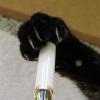
Urushi Studio India Goldfish pen impressions and comparisons
jandrese posted a topic in India & Subcontinent (Asia)
I collect urushi and maki-e pens some of which are from India. Here is my Urushi Studio India Goldfish pen impressions and comparisons. First, I show below photos of the pen by itself then photos alongside Japanese pens with the same theme. 398CB59A-8CF7-4757-86E2-23AC7032FC21 by Ja Ja, on Flickr DDD9A3DA-A5A4-482E-87B8-EB2F9251CDF4 by Ja Ja, on Flickr 0AB601B8-1C2D-4B71-8201-AAB972792F21 by Ja Ja, on Flickr 2BE10825-8A09-4EE9-AE61-0F210CF727A9 by Ja Ja, on Flickr D0113742-49BC-4DC8-B125-F1D9C168B868 by Ja Ja, on Flickr Overall, the Urushi Studio India pen is an attractive and unique take on the traditional kingyo (goldfish) theme. The blue base color is remarkable for both the seeming obviousness of using blue when the Japanese use black, and for the difficulty of producing blue urushi. The rocks and goldfish are pleasantly raised urushi especially so the goldfish—the technique is subtle reminding one of the shishiai-togidashi maki-e oft used by Japanese artists when painting kingyo. Comparing the work to three examples of kingyo theme pens from Japanese manufacturers provides some informative contrasts. The three Japanese works are a Danitrio Hyotan by Yusai, a Stylo Art pen featuring Wajima-nuri, and a Namiki Emperor by Seiki. In ascending order of retail price the pens are Urushi Studio India, Stylo Art, Danitrio, and Namiki. The Stylo Art pen is priced only about 15% more than the Urushi Studio India pen whereas the Danitrio is ~2-fold the price and the Namiki tops the scales at nearly 10-fold. 1ED931C6-FA40-4F1A-B873-B8AC7EBE52B5 by Ja Ja, on Flickr The base color of all three Japanese pens is black, that is, polished black oil-free urushi (kuro roiro). The polished black base is highly traditional, glossy, and has a preternatural sense of depth. The Danitrio pen makes this finish a feature, which works well with the curvy shape of the pen, showcasing the perfection of the finish. The other two Japanese pens make use of the black surface more as backdrop for subsequent maki-e work. The black contrasts with the colorful maki-e work but being black does so equally for all colors. Black and gold can also combine to look brown-ish or form a stunningly rich contrast. The polished blue of the Indian pen immediately signals a non-traditional approach while the glossiness of the finish advances its quality. It is said that obtaining consistent blue urushi finishes are difficult so those in the know may appreciate some added difficulty in the preparing the base finish. There are, however, spots of inconsistency in color/gloss speed throughout the blue base coat that are apparent on close inspection. The blue color suggests a realistic depiction of an underwater scene although a more naturalistic color scheme would make use muted earth tones. Being opposite on the color wheel from orange the blue base forms a strong color contrast with the colors used on the goldfish. This is simultaneously attractive and sharply obvious. 21646BA8-3343-4208-9435-A29197FC664D by Ja Ja, on Flickr A bed of rocks are key elements on both the Urushi Studio India pen and the Namiki Emperor. On the Namiki the results are splendid with a multilayered, multicolored believably realistic depiction of a rocky bottom interspersed with foliage. Many maki-e techniques are on display including raised and polished work, multiple metal powder gradients, colored urushi, nashiji, and kirigane (inlaid gold foils). The Urushi Studio India pen also uses multi layered maki-e to depict the rocks yet has a comparative lack of details. The rocks are thickly layered rendered in black with a simple gradient of silver metal particles the texture of which can still be felt. The Namiki better integrates foliage amongst the rock and extends the subsurface to the very end of the pen with nashiji whereas the Urushi Studio India pen leaves a tip of blue at the end of the pen. 2A355D6C-A762-4827-8F2D-92AFAD973A7B by Ja Ja, on Flickr All four pens employ depictions of aquatic plants with the Namiki and Danitrio elevating the work to the highest levels. This is especially so on the Namiki but the clever placement of the plants on the Danitrio along with the the thickness of the lines as well as their subtle color shifts indicate high quality workmanship. The plants are more two dimensional on the Stylo Art pen but the shapes and colors are in keeping with the Namiki and Danitrio pens. The Urushi Studio India pen takes some liberties with its depiction of aquatic plants. The centerpiece looks more like a coral than a freshwater species and the overall color scheme is not as cohesive. The plant colors include silver, red, green, pink, and yellow that lack a sense of being clearly freshwater species that live in the same environment. Two of the pens use bubbles to enhance the underwater scene whereas the other two use gold particles. The bubbles on the Danitrio are rendered with raden, which adds to the visual and textural complexity. On the Urushi Studio India pen the bubbles are silver circles. Rendering the bubbles on the Danitrio is both a higher skill and a more time consuming process. On the Stylo Art and Namiki pens gold particles are used to indicate sand, texture, particles suspended in the water column, and light (the Namiki adds silver particles to enhance the sense of light). The maki-e work on these two pens adds a great deal of dimensionality and dynamism to the scene that is lacking on the less complex pens. 5A787263-2B46-4780-836B-A4F92E5238E5 by Ja Ja, on Flickr Now for the main attraction, the goldfish or kingyo. These pens depict Wakin kingyo, which is the most common kind of Japanese goldfish and the one that forms the basis for all the other types. Kingyo traditionally symbolize wealth, prosperity, and abundance. The red and shimmering gold colors of the goldfish are Summer colors as is green and blue. All four pens offer different depictions of the goldfish. Namiki’s is the most complex visually and artistically. The color scheme of the Danitrio goldfish matches that of the Namiki, and the artwork is similarly delicately raised but the overall approach on the Danitrio is less involved. The fish on the Stylo Art and Urushi Studio India pen are similar to each other although the Stylo Art proves the richer and more complex execution. FF8D6A9A-7FBF-4C15-8031-14E482642850 by Ja Ja, on Flickr Focusing just on the Urushi Studio India pen the goldfish are not shiny as they are on the other three pens. At the risk of anthropomorphizing the goldfish the expression is a frown on the Urushi Studio India pen whereas the others have a neutral expression. The scale lines and the lines on the fins are not regular, which affects the flow of the design causing the eye to wander. The Japanese work is typified by precise, regular, and delicate line work. The micro surface of the Urushi Studio India fish is uneven, which contrasts with the smoothly polished surface of the fish on the other pens. Diffuse and gradient gold particles are used on the Japanese pens to give texture and increase the color depth of the fish. The Urushi Studio India pen does not make use of gold particles except on the lines. The delicate flow of the goldfishes fins are rendered splendidly on the Namiki pen followed closely in effect by the Danitrio then the Stylo Art. The Urushi Studio India pen gives a large surface area to the fins, which is in keeping with the Namiki design but lacks the textural complexity and wispy sense of motion imparted by the Namiki and Danitrio depictions. Uniquely, the Stylo Art pen uses raden for the goldfish eyes, which is an inspired choice that elevates the artwork that otherwise lacks some of the complexity shown by the Danitrio and Namiki fish. In summary, Danitrio goes for simplicity and executes to perfection. Namiki uses complexity and executes to perfection. Neither are easy to accomplish. The Stylo Art and Urushi Studio India pens are in between those extremes although in design terms the Stylo Art is most akin to the Namiki whereas the Dantirio and the Urushi Studio India take a similar similar approach. That the Urushi Studio India pen can comfortably sit beside the Japanese works is impressive. Taken on its own, and seen with the eye not an unrelenting macro lens, the Urushi Studio India pen is a vibrant joy to behold. It has all the visual and textural appeal of good raised maki-e. Given time and increased experience no doubt the relative unevenness in design and execution will improve. It is exciting to see the development of new urushi and maki-e artists outside Japan that are creating new works in their own styles using these traditional techniques.- 11 replies
-
- urushi studio india
- urushi
-
(and 5 more)
Tagged with:
-
This is the Namiki Yukari Royale Frog in full focus stacked macro glory. Namiki calls this motif Frog. There is more than one frog but more importantly the dynamism and joy of the piece jumps off the pen. Note the different colors of urushi and raden to depict the water. I'd call this pen Happy Frogs. Focus stacked curves up color shift yes logo by Ja Ja, on Flickr frogs focus stacked with logo by Ja Ja, on Flickr
- 4 replies
-
- namiki
- yukari royale
-
(and 3 more)
Tagged with:
-

Danitrio Mikado eyedropper pen leaked-a comparison with a Namiki Emperor
jandrese posted a topic in Japan - Asia
One of my Danitrio Mikado (eyedropper filling model) pens leaked on me at work. That is Noodler’s Navy you see on the section in the first image. I collect Danitrio and this sort of thing happens more often than I care to admit on their eyedropper filling pens. I still collect Danitrio but stopped buying eyedropper models a couple of years ago. At this point I know all the potential ways in which a Danitrio can leak. This one leaked at the junction between the section and the barrel. Naturally, with a leak like this you don’t know it’s happening until you look at your inky hand so that’s nice. There is no obvious reason for the leak, which led me to investigate further. To do so I thought a comparison to a Japanese eyedropping pen that has never leaked on me was in order. Thus, I cleaned out the Namiki Emperor I had with me at work and set about comparing the two pens. What have I learned? 1) That even compared to a Namiki Emperor the Danitrio Mikado is a big pen and looks great. Feels good to hold and to write with and that stub nib is extra nice. Seems to be on par with the Namiki on looks and feel but… 2) The section engineering and machining execution is different between the two pens. The concept is the same—eyedropper with shutoff valve—but the Namiki has some advantages. a. The Namiki threads are finer pitched and better machined inside the barrel and on the section. This can be felt when screwing in the section; there is a smoother feel and less play. b. The threaded portion of the section has a bigger diameter on the Namiki. The overall diameter is 10% greater and but the ratio between the diameter of the grip portion and the threading is also 10% greater on the Namiki. c. The o-ring on the Namiki is more precisely seated, that is, it has no room to move about. d. Both o-rings fit into a slot in the barrel that is flat and smooth before the threads start up. The slot on the Namiki is not as deep. I have a gang of Danitrio pens that fill by eyedropper. One or two have never leaked on me at the section. This pen used to be one of them. The problem is at the level of the o-ring. There is too much potential for the o-ring to move about, get twisted, or otherwise compressed in an uneven fashion. It only takes an infinitesimal gap for ink to leak. Water always finds the path of least resistance. A little side pressure from your grip and the heat from your hand is all it takes to set the leak in action. Part of loving Danitrio seems to be leak mitigation. Changing o-rings has helped in the past on other pens but o-rings that fit are not easy to come by. Danitrio themselves does not seem to have consistently sized, readily available replacement o-rings. That bit about consistently sized o-rings may make more sense knowing that there is more variability between Danitrio pens of the same model than Namiki pens of the same model. I reckon Namiki buys only one size of o-ring that always fits like it is supposed to. I admit that it all is a bit frustrating, but I press on. IMG_8517 by Ja Ja, on Flickr IMG_8529 by Ja Ja, on Flickr IMG_8535 by Ja Ja, on Flickr IMG_8539 by Ja Ja, on Flickr IMG_8541 by Ja Ja, on Flickr IMG_8543 by Ja Ja, on Flickr -
Shooting the Sailor Bespoke KOP Chinkin Owl for Dromgoole’s inspired me to pull out my Namiki Emperor Chinkin Dragon and run it through the focus stacked macro ringer. I’d say it availed itself. F8B88398-F81A-4B6A-A5F5-C981F315526F by Ja Ja, on Flickr EE178EB1-23E4-4056-B7BB-80B3EDD2E062 by Ja Ja, on Flickr
-

Namiki Limited Edition 2021 Coral Emperor in full macro glory
jandrese posted a topic in Japan - Asia
This is the Namiki Limited Edition 2021 Coral Emperor in full macro glory. Drink it in. This pen is above and beyond in every way possible. _SON4578 by Ja Ja, on Flickr _SON4577 by Ja Ja, on Flickr _SON4580 by Ja Ja, on Flickr _SON4582 by Ja Ja, on Flickr _SON4584 by Ja Ja, on Flickr _SON4583 by Ja Ja, on Flickr _SON4585 by Ja Ja, on Flickr _SON4586 by Ja Ja, on Flickr- 3 replies
-
- namiki
- naimki limited edition 2021
-
(and 3 more)
Tagged with:
-

Namiki Limited Edition 2021 Coral Emperor first look and writing sample
jandrese posted a topic in Japan - Asia
Here is the mighty No. 50 size Namiki Emperor in the 2021 Limited Edition Coral maki-e. Words cannot express the amazingly superlative incredibleness of this pen. I have some pretty awesome macros I can share in a followup post if anybody is interested. IMG_8256 by Ja Ja, on Flickr- 16 replies
-
- namiki
- namiki limited edition
-
(and 4 more)
Tagged with:
-
Dear Penfriends I am building my collection with Namiki pens - can't get enough of them... I love the look and feel of the Urushi. I do own a Vermilion No 50 from 2019 and I would love to get a black No 50 with the old nib. It seems like Vintage Namikis (and Namikis on the 2nd hand market in general) are really hard to find... Does anyone know where I can get this pen? Regards from Zurich, Lars
-
Hello all, hope you and yours are doing well during these odd times. I am reevaluating my ‘desirables’ list of pricier fountain pens and attempting to narrow down my choices a good deal. For example, I’ve recently removed the Montblanc l’Aubrac after finally getting a chance to try one and being disappointed by the slippery metal section. (Why, Montblanc? Also, why do I trick myself into thinking I won’t mind it, every time?) The basis for my pruning of the list is that I want a pen I can use. I write a lot, usually for several hours everyday. I’d told myself that this ought to limit my quiver of pens to only the most utilitarian models. Nakaya is out, on account of their tiny ink capacity. Sailor—whose nibs are my absolute favourites—is also out, unless I put their nibs in a Conid. However, the Con-70 is a fair capacity converter, and much easier to clean than an eye dropper, so the Yukari Royale remains on the table. Why can’t I have a pen that’s gorgeous and practical? As I try to inject some majesty back into my rotation of pens (all delrin Conids and ‘precious’ plastic Montblanc) I see myself drifting further towards the Yukari Royale. It is beautifully lacquered, yet tastefully subtle, black with reserved furniture. It is unassuming, which for me is a huge plus. The last thing I want is someone to ask me about my pens. I have to work hard to hide the Montblanc snow cap if ever I leave the house with one of them. I’m counting on the uninitiated not recognizing the Namiki clip, as no one ever makes a fuss about the Conid final. The review on this forum have been wonderful, by the way. There are some effective reviewers and spectacular photographers in this community. For that, I owe you all my thanks. So, all told I am simply looking for opinions on the viability of the Namiki Yukari Royale as a moderate to heavy use daily writing pen. It’s hefty, but only seven grams more so than my Conid inked and uncapped. It’s lacquered, but urushi’s withstood more abuse over the centuries than I ever intend to throw at it. Does anyone actually use this pen to get some decent chunks of writing done? Any insight, advice, or words of caution would be greatly appreciated. Stay healthy, stay happy, folks.
-
I was very fortunate to find a used Namiki Impressions c. 1996 in emerald green today at a local brick and mortar. This pen accommodates the large Pilot CON-70 converter. I tried two different CON-70s, one of which was brand new in a factory sealed package. Neither grips the section securely. I inspected the section and don’t see anything broken (as can sometimes be the case). Does anybody have a repair suggestion for this problem? I could return the pen because the store has a liberal return policy, but an emerald green Impressions is pretty rare. I have sent pens back to Pilot and I’m sure they could replace the section, but that will take months and probably cost $100+. If there is an easy fix, I’d love to find it first. Thanks for reading, and for your suggestions!
-
Hi, I am looking to buy a pilot custom 74 in a fine nib(soft is preferred). My only criteria is that it writes smooth and isn't too weared out. If you have a custom 74 you'd like to sell or trade, hit me up and we can talk about the pricing!
- 2 replies
-
- fountain pen
- pilot
-
(and 8 more)
Tagged with:
-
Namiki Emperor Rakucho and Cherry Blossom. The Rakucho is an imaginary bird flying in paradise. Represented as a couple, it suggests the hope of a long and happy marriage, accompanied by a mutual desire for eternity. Cherry blossom petals are inlaid with mother of pearl and polished for a refined finish. The Sakuragawa, cherry bark structure, evoked as a background on the barrel, is created using the Oh-Hi-Nuri, a traditional way of painting cherry blossom bark. In stock since a few days only! https://www.sakurafountainpengallery.com/en/boutique/detail/new-emperor-rakucho-and-cherry-blossom-namiki-emperor-collection Sincerely, Catherine
-
- namiki
- rakuchoandcherryblossom
-
(and 1 more)
Tagged with:
-
Some pictures of the no 50 nib found on the Namiki Emperor. http://i991.photobucket.com/albums/af39/hari3171/Namiki%20Emperor%20Pavilion/IMG_0179.jpg 43.5mm long from tip to heel: http://i991.photobucket.com/albums/af39/hari3171/Namiki%20Emperor%20Pavilion/IMG_0180.jpg 11mm wide across shoulders: a gigantic nib http://i991.photobucket.com/albums/af39/hari3171/Namiki%20Emperor%20Pavilion/IMG_0181.jpg http://i991.photobucket.com/albums/af39/hari3171/Namiki%20Emperor%20Pavilion/IMG_0182.jpg The semi lacquered (urushi)feeder, some descriptions note the feed material as Ebonite, this example looks and feels like the typical superb plastic Pilot feeders: http://i991.photobucket.com/albums/af39/hari3171/Namiki%20Emperor%20Pavilion/IMG_0184.jpg http://i991.photobucket.com/albums/af39/hari3171/Namiki%20Emperor%20Pavilion/IMG_0185.jpg 55mm long and 9mm feeder diameter: http://i991.photobucket.com/albums/af39/hari3171/Namiki%20Emperor%20Pavilion/IMG_0186.jpg Hallmark (Ste PP F)and date stamp a1103: http://i991.photobucket.com/albums/af39/hari3171/Namiki%20Emperor%20Pavilion/IMG_0187.jpg http://i991.photobucket.com/albums/af39/hari3171/Namiki%20Emperor%20Pavilion/IMG_0188.jpg http://i991.photobucket.com/albums/af39/hari3171/Namiki%20Emperor%20Pavilion/IMG_0189.jpg Cheers! Hari
-
Namiki Emperor Shijin Limited Edition 2020. We expect this limited edition in October! The "Shijin", traditional figures in Chinese mythology, are represented by four sacred animals, guardians of the four cardinal directions in Feng Shui art. Each "Shijin" is associated with a symbolic color and an element that makes up the natural world : wood, metal, fire, and water. Contact catherine@sakuragallery.com https://www.sakurafountainpengallery.com/en/boutique/detail/new-namiki-emperor-shijin-limited-edition-2020-namiki-2 Seiryu and wood: A powerful dragon with the hooves of a deer and the body of a snake represented by a bright blue-green color. It protects the East, controls the element of wood and symbolizes wealth. Byakko and metal: A spiritual tiger who has survived 500 years, represented by shades of brilliant white. He protects the West, governs metal and symbolizes fertility. Susaku and fire: A magnificent phoenix, guardian of the South. Associated with shades of flaming red, it wields the element of fire and symbolizes beauty and intelligence. Genbu and water: A turtle, eternally intertwined with a snake, it promotes human relations. Associated with shades of deep black, it is the guardian of the North, the mistress of the water and symbolizes longevity. Contact catherine@sakuragallery.com
-
Another new Namiki : the Emperor Rakucho and Cherry Blossom. The Rakucho is an imaginary bird flying in paradise. Represented as a couple, it suggests the hope of a long and happy marriage, accompanied by a mutual desire for eternity. Cherry blossom petals are inlaid with mother of pearl and polished for a refined finish. The cherry bark structure (sakuragawa), evoked as a background on the barrel, is created using the Oh-Hi-Nuri, a traditional way of painting cherry blossom bark. This Namiki Emperor Rakucho and Cherry Blossom is signed by artist Masahiro Yamada and will join the Namiki Emperor collection from 15 November 2020. Coming in November. Reserve yours at catherine@sakuragallery.com https://www.sakurafountainpengallery.com/en/boutique/detail/new-emperor-rakucho-and-cherry-blossom-namiki-emperor-collection
-
Hi everyone, I was hoping someone could help me. I bought a black Namiki Emperor with an M nib (foolishly) before researching some writing samples. Having looked at some now I would prefer to get it with an FM nib. Does anyone know what Namiki’s policy/procedure is on doing this? The seller is looking into it as well but is short staffed due to coronavirus, and getting a response is taking a long time, all the while the pen is sitting unused in its box and packaging, which is very sad! Thanks!
-
I am doing some research on this, and there are only a handful examples that I have found. Obviously the best way to have a more comprehensive overview is to have the same person with the same ink to do a writing comparison between the available nibs, but this is a bit of a stretch-out scenario. So, could you please upload some writing examples with your nib sizes, I am more interested in the F (Fine) and FM (Fine Medium) region. Intend to use it, as an note taking instrument. Although the F is not being manufactured any more from Pilot/Namiki, the FM has taken its place. Any help would be very much appreciated, I have experience with Pilot nibs in the F region from 823 and 845, but these are No. 15 size nibs and although they could be taken as a rule of thumb, wanted some re-assurance from the actual users. Thank you!
- 8 replies
-
- namiki empreror
- namiki
-
(and 1 more)
Tagged with:
-
Dazzled by the resplendent allure of a Japanese ED (with the concept of a shut-off valve mechanism), the lust for an urushi lacquered pen vis-a-vis plain ebonite ones (seemingly susceptible to lose shine and colour over time) did keep growing on me for some time, before I took this plunge! I have come to know of an unfortunate experience with a Sailor KOP in Ebonite and have felt that without urushi, ebonite just fails to complete itself. These glamorous reviews from shuuemura and rubyeyespenlover should be banned and blamed altogether for pen-monetary crises, which I kept visiting again & again. These reviews did make me aware of huge dimensions of the Emperor more towards a ‘at rest desk-pen’, with a reassurance of writing comfort. I will keep this review unrated, since beautiful things in life do not need logic or mathematics to impart you with joy. So when I was dazzled for long enough, I asked Raul (Engeika/Pensindia) for an opinion regarding the Emperor vs Yukari Royale. Since most of our discussions these days refer to trade economics, Government taxation rather than any real pen discussions, he lazily took two to three days to check with Namiki and confirmed me back with the nib availability for both the pens. He gave me a discounted price (which I shall not discuss) for the Emperor model, more as a friend than a seller. I went ahead with it, because the production of Emperor pen without rings had been stopped by Namiki and it would become difficult to acquire a preferred nib-width. The beauty travelled from Japan and reached me via Pensindia Pune office in less than two weeks. Below links redirects to the same review on my blog with additional eye-candy The Namiki Emperor Review A JUMBO HISTORY OF 85 YEARS In early 1930’s, the Emperor existed in the form of No.50 Jumbo. It was decommissioned a few years later. On one rare occasion as referenced here, Nomura securities (estd 1925) had a specially commissioned No. 50 Jumbo pen made for itself, with Dunhill-Namiki engraved (with the classic M-shape logo) in 1936, for distribution among its employees to celebrate the 10th anniversary of the company. Wow! how many companies would do that today? http://1.bp.blogspot.com/-DOvvGuEJKqs/VpH7jevYvYI/AAAAAAAAFq0/CsZeYqgPhiI/s1600/1DNomuraEmperor.jpg Pilot reintroduced the pen in 1985 to tap the high margin market, as referenced here. The task was left to Sakai Eisuke to create a No. 50 Jumbo prototype based on the 1920s model. The initial model had a 14k nib with the 14 KARAT NAMIKI <NIB WIDTH> REGISTERED PATENT OFFICE 50 inscription, which later got replaced with a 18k nib carrying a similar engraving. http://4.bp.blogspot.com/-s6NfGjeSk8w/VpH7RGtu0QI/AAAAAAAAFqs/GB5ABo05-ZE/s1600/2Dkarat.jpg These days it comes with Namiki’s standard Mt. Fuji inscription. The finish of these Urushi lines is obtained by using non-oil lacquer for the final coat and a polishing method called Roiro Urushi Shiage (Non-oil lacquer finish) as per Namiki. It’s done by rubbing the pen in raw lacquer after a special charcoal polishing process. And if you look at the plain Urushi line of pens (vermillion & black), the artisan’s name would say Kokkokai. Kokkokai is a continuation of the original group of Maki-e artisans formed in 1931, under leadership of Maki-e master Gonroku Matsuda, who had joined Ryosuke Namiki back in 1926 as Chief Maki-e Designer. Matsuda is said to have designed for Montblanc too. URUSHI Urushi, as you know, is the poisonous sap of the urushi or lacquer tree (Toxicodendron Vernicifluum) which grows in Japan, China, and Korea and is primarily brown in colour. The sap of this tree polymerises to form a hard, durable, plastic-like substance, when exposed to moisture/air. Liquid urushi can be applied to multiple materials like wood, metal, cloth, resin, ceramics or ebonite as opposed to the best of synthetic lacquers. When it solidifies, Urushi turns into a very hard coating that is waterproof and protects the coated object from effects of fungus, ambient chemical reactions at surface due to heat or humidity or even from caustic acids. Colored urushi such as black or shu (red) are made by mixing pigments into cured urushi. With natural exposure to air and ultraviolet light (extended UV exposure ends up in discolouration), the urushi layers gradually increase in transparency and the material gradually unveils shades of original bright colours within. The birth of the maki-e decoration technique took place during the Nara period in Japan i.e from 710-794 AD, in which gold ''dust'' was decoratively sprinkled on the lacquer surface. So maki-e utensils, accessories and writing instruments have evolved to their present forms from thousands of years ago. Only direct and prolonged exposure to sunlight will cause urushi to deteriorate. Urushi's hardness and durability makes it an excellent protective coating for any object that will be used continously over a long period of time (Paraphrased from Kyotoguide). This all ends up with a versatile material and with a characteristic hardness, durability, imperviousness and resistance to abrasion. The elegance of ebonite is supposed to endure time and space with the urushi flair. PRESENTED BY NAMIKI The presentation is grand and velvety with a spacious wooden box, capable of packing your sneakers too, which is made out of traditional Paulownia wood. It is protectively packaged inside a cardboard box. The box has a violet thread running across two metal brackets to fasten the upper lid. http://4.bp.blogspot.com/-9i49GFleh2s/VpH8AAE7BbI/AAAAAAAAFrE/_zK1K3OQsuI/s1600/3presentation.jpg Resting inside is a bottle of Namiki Black Ink (Pilot Black Ink - 50 mL), an Ink dropper with a red bulb encased in a black cardboard box, a red velvety polishing cloth and finally the No#50 Jumbo resting on its bed. I did receive a nice surprise gift from Pensindia - it is a Pilot Somes single-pen pouch. Thank you! (PS : The Emperor would not fit inside this standard Pilot Pouch). http://2.bp.blogspot.com/-2WKlYSJpjtU/VpH8ERxDtzI/AAAAAAAAFrM/xbk5oAk0wI0/s1600/DSC_7536.jpg The model number of the pen, in this case FNF-148S-<R/B>-<F/FM/M/B> indicates the launch price and colour within it. The 148 refers to JPY 148,000 whereas the third digit R/B refers to the red/black urushi. DESIGN - CLASSIC This Lacquer No.#50 model comes in two standard colours - Black & Vermillion (Urushi) with gold plated clips. A newer No.#50 Urushi model is available with two concentric rings on the cap, carrying a different model number. The ebonite feels substantial in hand from dual perspectives of dimensions but at the same time the pen does not feel heavy. The classical cigar or rather torpedo shaped geometry with Vermillion hue adores itself with light, which when reflected through multiple layers of urushi takes on a electric red tinge on an otherwise conservative scarlet red hue. The work and finish is impeccable and it does not show any signs of being handmade, whatsoever. The simplistic yet elegant design comes with a single golden accent, provided deftly by the traditional triangular shaped tension fit clip with a sphere to anchor into your shirt pockets, if you have that big a pocket. A marked absence of any other decoration like a clip band or ring or anything else on the entire pen, imparts a continued infinity to modes of convergence. Vermillion is considered as an auspicious colour throughout East Asia, where it’s culturally imbibed. It has four synthetic & natural shades as of today: Red-Orange[sRGB (255, 83, 73)], Orange-Red[sRGB (255, 69, 0)], Plochere[sRGB (217, 96, 59)] and Chinese Red[sRGB (170, 56, 30)]. The shades/hue of the pens in red urushi might vary from one other. http://3.bp.blogspot.com/-0DjoRXVscp8/VpH8UHvolGI/AAAAAAAAFrU/oMSLVGdluQA/s1600/DSC_7544.jpg The cap unravels itself after one and a half turns. It reveals the beautiful nib with the modern Mt.Fuji inscription which is incidentally 1.1 cm longer than the section itself. The seamless grip goes through a fair amount of taper starting from the barrel and ends up with a smoothly carved out bumper, emphasising continuity. The cap threads on the barrel are carved out with sculpted finesse and the grip section ends up with a small but discernible gap between itself and the barrel (common across the Urushi models). The barrel at the other end leads leisurely to the tail where you have the ink-shutoff valve. This picture thankfully captured the tail end, which your eyes might fail to notice, unless you know where you are looking for it. http://1.bp.blogspot.com/-zDgaI9nQ92M/VpH9FEL4wWI/AAAAAAAAFr8/FYWgzXkUHw4/s1600/DSC_7558.jpg I feel, the cap is itself a subtle piece art made from a single ebonite blank. It carries the valour and brevity of the overall smooth curved design with remarkable panache. The finish is impeccable, with the colours varying between bright and dark with the play of light. The clip is traditional triangular Pilot with a sphere at the end, inscribed with Namiki with the Isosceles Triangle within a Pentagon logo. There is a alphanumeric code inscribed on the upper base of the clip, where it delves into the cap. http://3.bp.blogspot.com/-L1s1oI7rJsU/VpH8ms913sI/AAAAAAAAFrc/rv1zcJpmu6k/s1600/DSC_7559.jpg FILLING SYSTEM - The ‘Japanese’ Eyedropper A bit of history on it, there were these traditional non-self filling systems or NSF (without any filling mechanism - piston/button/plunger) and luckily enough fountain pens were compulsory during my junior school days. Since the squeeze converters/cartridges did not last long, we used to bank on fountain pens from Camlin & Chelpark which used to offer the capacity of the barrel itself. However, sometimes we did end up with ink inside the cap and sometimes a blue blot on pockets of our white shirts (our school uniform) due to ink burping & subsequent leakage. If I remember correctly, Surf made all the money those days, using this particular advertisement with an ink blot on white pockets in TV media. Seems the burping had mattered to the Japanese first, thanks to their costly Kimonos made of silk, when they had come up with an ink stop - plunger mechanism in early 1912. The term ED (Eyedropper) came into picture after advent of vacuum driven self filling pens with button, squeeze or plunger mechanisms. Now comes the ink-dropper with the red bulb to make an appearance. The section takes almost eternity (read seven complete turns) to reveal one of the most basic fountain pen filling systems. Most of the times, I fear the section would drop off due to my monotony and laziness during unscrewing the section. Once unscrewed, you can see the conical ink shutoff valve inside the barrel and a similar conical concavity with a crevice inside the section, to make the system work. The insides of the barrel & section are all black. With the dropper filled up with your favourite ink, you are supposed to be fill the barrel, until the visible internal threads. Leave the valve shut while filling the barrel, then unscrew one turn to allow air inside the chamber while writing and then close when finished. The entire rod is to be extracted completely, only when you are cleaning the barrel. It seems to be a delicate system, so one must avoid pulling the rod frequently. While using, you can unscrew the tail by 1 mm or so and start writing, although the feed might have a buffer comparable to a converter. After use, you can follow the instruction of screwing back the tail with the nib turned upside. http://4.bp.blogspot.com/-38ZntEubEJ0/VpH80L-G8JI/AAAAAAAAFrs/hHEZLBvClT4/s1600/DSC_7560.jpg NIB - LORD OF THE NIBS The nib with this Emperor is 18k which weighs more than 2 grams and it came in four stock widths earlier - F, FM, M & B according to the enclosed booklet. It seems F and B nibs have run out of stock for Namiki/Pilot Office in Japan. The nib isn't anything short of grand, but believe me it takes time to get used to it. It’s longer than the section by more than 1 cm. Inscribed is the symbol of Mt. Fuji (also found in #3776 nibs), the upper part symbolic of the snow caps. http://1.bp.blogspot.com/-2GOBuk35mhg/VpH8vZhUZeI/AAAAAAAAFrk/QfublMrzLU4/s1600/DSC_7572.jpg The oval breather hole rests within the snow caps. Below the snow, etched are the Namiki Logo (Isosceles triangle inside a Pentagon), Namiki, gold alloy specs (18k-75%) and Nib width <M>. The nib is sharply curved compared to usual flatter Pilot nibs, at its shoulders & tines, as a continuity of the precision followed by Kokkokai artists, while making the pen. http://3.bp.blogspot.com/-gldtXZdK_9M/VpH9DGm_ZQI/AAAAAAAAFr0/j0aGj4KseZM/s1600/DSC_7573.jpg On the left the #50 nib carries the Namiki Logo Ste PP-F hallmark and on the right it carries the date stamp. Mine is a707, “a” as I understand refers to the machine/plant where the pen was made and 707 as usual refers to July-2007 manufacturing. http://3.bp.blogspot.com/-iuwzbWJ4Bao/VpH9pwLIaLI/AAAAAAAAFsU/KsE1WGTuDXU/s1600/DSC_7584.jpg The semi-lacquered plastic feed (red urushi) converges majestically with the overall design of the pen. The big fins ensure levelling ambient air pressure and give you a really worthy buffer (from underside the nib). You can write a few A4 pages with the shut-off valve/tail closed. When I filled the pen for the first time, the feed took some time to respond, but when it did, it was with a nice and consistent flow, and after that it was pure performance. http://2.bp.blogspot.com/-yw2qJX8g6ns/VpH9YIKs1LI/AAAAAAAAFsM/SDTrU1vB4Z8/s1600/DSC_7585.jpg PHYSICS OF IT – RELATIVELY SPEAKING This is in no way a daily carry pen designed for extensive use as a travel companion. For a daily pen, I assume that a Yukari Royale would fit the bill well albeit with a smaller nib. I take special care and limit the pen to home use only. The ebonite body keeps the pen warm & comfortably balanced for writing. The pen is in fact quite comfortable to write with, even for an extended period of time. The grip is temperate and soothing, showcasing the better qualities of ebonite, with urushi sustaining its demeanour. Posting the pen is probably an impossibility for me, given the size, finish or value of the pen. I really do not have any pen to compare it with, though I strongly feel that the Emperor deserves a place of its own. A slight disadvantage in my experience occurs when I change back to a m605 or a 3776, and I have a funny feeling of missing a nib altogether, for the first few moments. Figures for weight and dimension run below in case you need to compare it with a familiar pen. Length closed ~ 17.3 cmLength open ~ 15.8 cmGrip Diameter ~ 1.4 cmNib Leverage ~ 3.3 cmWeight (without ink) ~ 46 gWeight (without cap) ~ 30 g Capped, uncapped Emperor poses with an MB149 and Izumo Tagayasan with an apparent disdain for their great magnitude. http://1.bp.blogspot.com/-P2lOtIuz804/VpH9wDlNEgI/AAAAAAAAFsc/A3AqaJNd29I/s1600/DSC_7612.jpg http://3.bp.blogspot.com/-_vhLzb4MxWQ/VpH928tQsvI/AAAAAAAAFsk/npW_61zR1go/s1600/DSC_7624.jpg ECONOMIC VALUE The Emperor retailed at around USD 1600 in the US, although you can find it at lower prices in Japan. Moreover, the production of Emperor without rings has been stopped now and Raul was kind enough to arrange one for me. Technically speaking, I bought the pen from Engeika’s Indian Arm - Pensindia. Logically the economic value should be equal to salvage value of the pen after a few years of use and I don't think the price will vary by much even after a few years use with proper care, given that someone decides to sell it off. Having said that, even though the pen is one of its kind and the lacquer finish is impeccable, you should give it a serious thought, before taking this kind of a plunge. It will result in a fair amount of money being locked up within the urushi layers! OVERALL The medium nib is graced with a wet flow. It’s neither butter smooth nor with any noticeable feedback, strictly speaking. You will right away know it’s a Pilot nib, in case you have used any of the Pilot pens with a Size#15 nib like a Custom 823 or Custom 845. And it does share its basic DNA with its cousins. I feel that some characteristic spring and softness comes naturally to the Emperor because of the size & shape of the nib, rather from its gold content. The verticals grow thicker even with a little bit of pressure. With a high buffer capacity of the plastic feed and its magnificent fins for pressure balance, the nib imparts a beautiful shading to the letters in Iroshizuku Tsuki-yo ink. The ink takes around 45 seconds to dry completely on Tomoe River paper. http://1.bp.blogspot.com/-VNBh6tN6-aM/VpH-L4gxzxI/AAAAAAAAFss/MRCp8CXFcjA/s1600/DSC_7656.jpg Thank you again for going through the review. Wish you a prosperous new year. You can find other pen and paraphernalia reviews here. SOME CAUTIONARY GUIDELINES FOR URUSHI LACQUER CARE I felt like including some pointers regarding care of urushi lacquered pens here, since it will help me more than the reader (most of whom are extremely knowledgeable). The points are derived from this FPN Thread. AVOID Ultraviolet light - direct sunlight, UV lamps, halogen lamps.AVOID Continuous exposure to visible light which can alter colour, transparency and appearance.Do NOT soak in water.Store in a dark place to prevent undesirable changes.Do NOT store the pen in an excessively dry or desiccating environment for long periods like inside the fridge, with silica gel etc.Do NOT use abrasive cleaners or polishes, use a soft cloth damp if necessary, to wipe the pen Do NOT have to apply anything to the surface of urushi: oils, stinky tofu, silicone or otherwise. REFERENCES Dunhill - Namiki Jumbo#1930s Gonroku Matsuda About Urushi FPN Thread on Care for Urushi lacquered pens
- 152 replies


